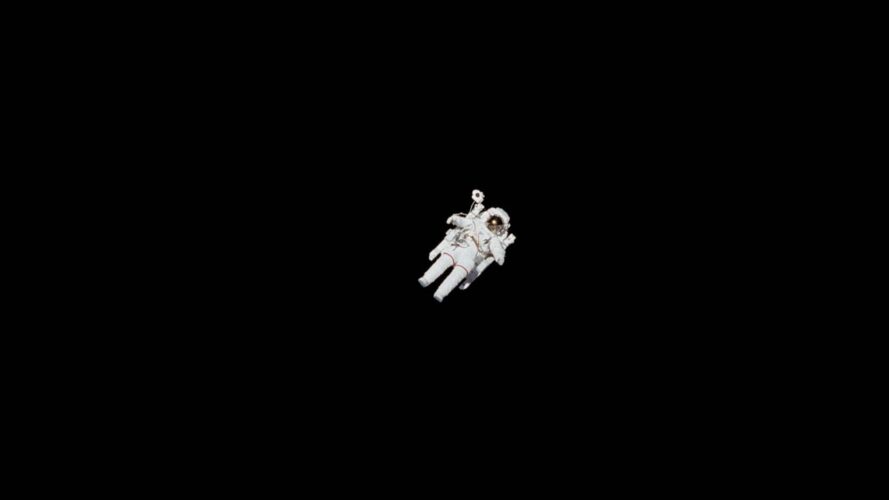It’s spooky season, so I thought I could talk about the scariest thing imaginable – the absurdity of space, time, and existence.
TRANSCRIPT:
On February 7, 1984, 197 miles (317km) above Earth, Bruce McCandless pushed away from the Space Shuttle, and into the history books. Taking the largest first step in human history.
While Neil Armstrong’s small step was a giant leap for mankind, Bruce McCandless’s first test of the Manned Maneuvering Unit was a plunge into infinity.
Space is big. In size, obviously, but also in the way it stirs our imaginations. The very concept of “nothing” is hard to fully process, and if space is anything, it is a whole lot of nothing. Potentially infinite nothingness.
But at the same time teeming with monstrous structures and energies beyond human comprehension. Filaments made up of thousands of clusters of galaxies, each with hundreds of billions of stars.
Areas of space so dense and massive that the rules of physics entirely break down.
And yet, when we look outside, we only see the very closest stars. All the rest of it is just out there, hidden in the endless darkness. Like an eldritch horror.
And yet, we feel inexplicably drawn to it. From our earliest days, we explored the infinite darkness, looking for meaning. We used the stars to navigate, to guide our planting of crops, we imprinted our gods and mythologies into the patterns we saw in them. We may not have known what was out there, but we knew it was important.
We invented eye-enhancing telescopes that reached through the darkness and found monstrous worlds we didn’t even know existed.
And now, in the modern era, we have taken our first tentative steps into the void, by packaging ourselves in suits and machines that simulate the conditions on Earth.
And we can’t survive in any of it.
Our world, in this perspective, is a microscopic oasis in a neverending inky void. As insignificant to the rest of the universe as a bacterium floating in the middle of the Pacific ocean.
Astrophobia is the fear of space, or astronomical objects. Astro from the Greek, ástron, meaning “star” and “phobia” from the Greek phobos, meaning fear. So technically astrophobia is the fear of stars. But we include space and celestial objects as well.
Objects like, say the Mars moon, Phobos. We literally have an object in the solar system named “fear.”
If someone from the city who rarely sees stars goes to the country or dark sky territory, they might find the immensity of a fully lit night sky to be overwhelming. Even nerve-rattling. We might say that person has a touch of astrophobia.
A believer of astrology might become nervous in the days when Mercury goes into retrograde. This could be considered astrophobia.
Or the old idea that people go mad under a full moon, turning them into luna-tics. That’s astrophobia.
In the ancient times, comets were thought to be harbingers of disaster. In fact, that’s where that word comes from. Dis-aster. Bad Star.
But there’s another type of astrophobia. One that’s not specific to an object or a superstition, but a something much deeper. A kind of cosmic existentialism.
Have you ever laid in the grass on a clear night and just took in the sky? Just let it wash over you and kind-of become a part of it. A strange sensation starts to come over you, that you’re not actually looking up. You’re looking down.
Below you is a drop into an infinite void, and the only thing keeping you from falling is the fact that you’re stuck to the ground by gravity.
This shift in perspective is a bit of a transformative experience, and I recommend everyone have it at some point in their lives.
Certain… chemicals can help that along, just saying.
But it’s a bit more accurate. In space there really is no “up.” There is no “down.” It’s just… out. In all directions. Forever. And the only thing keeping you from falling into it is this invisible force called gravity. Which we still don’t really understand.
And it’s a good thing because if you were to go out in any of those forever directions, you’d be dead after 5 miles. That’s it. That is as far as a human can go in that direction before we can’t breathe anymore. 5 miles. 8 kilometers. You could walk that distance in a little over an hour. That’s nothing.
And everything beyond that will kill you. Fear of space indeed.
We exist on a tiny sliver of space on the surface a tiny planet, and even in that sliver, we can only survive on land, which is only 29% of the total surface.
We exist on a tiny sliver of space on the surface a tiny planet, and even in that sliver, we can only survive on land, which is only 29% of the total surface. And even on that land, only 43% of that is habitable. The rest will kill you with oppressive heat, extreme cold and choking forests.
Earth can kill you in a million different ways, you can:
- Dehydrate
- Drown
- Fall off a cliff
- Get hit by lightning
- Consumed by fire
- Consumed by a lion
- Or a tiger
- Or a bear
- You could eat the wrong berry
- Or pet the wrong snek
- Or get bitten by the wrong bug
- Or go to Australia
- You could get blown up by a volcano
- Or breathe a toxic gas
- Catch a disease from a rat
- Or have a small number of blood cells clot up and travel to your brain.
Or…
Just wait long enough. One way or another, the Earth always wins.
Nobody has ever survived Earth. And yet… it’s the only place in our solar system we can survive.
If you teleported to the surface of Mercury, you would lose consciousness within 20 seconds for lack of oxygen, and in the vacuum of space, your skin would boil, as gasses in your blood flash into bubbles, like a carbonated soda. If you teleported to the sun side, your body would bake on the 800 degree surface (430C). If you’re on the shadow side, it’s immediate frostbite at -290 degrees (-180C).
If you went to the surface of Venus, you wouldn’t have time to suffocate from the lack of oxygen because you would immediately burst into flame from the 867 degree (464C) air temperature while simultaneously being crushed by an atmospheric pressure 92 times higher than here on Earth. It would basically be like the Titan submersible. But on fire.
On Mars, you might have a relatively warm day, but you’d still suffocate. There’s only 1% of our air pressure there, and almost none of it is oxygen. So you’d get the worst case of the bends imaginable and then pass out.
Teleporting to the surface of Jupiter would be difficult, because there is no real surface on Jupiter. Just thick atmosphere that gets thicker as you go down until it turns into liquids and solids and states of matter we don’t even understand. You would basically just fall until you were crushed into a diamond.
Somewhat the same thing on Saturn, but breathing the ammonia clouds would scorch your lungs first.
Neptune and Uranus are both so far away from the sun that the hydrogen atmosphere freezes solid. That’s why they’re called Ice Giants. Which is what you would be within seconds of going there. At -371 degrees (-224C), your body doesn’t freeze, it vitrifies. Basically turns into glass.
Space in Perspective
Our sense of scale about space is completely skewed because to show it remotely at scale, you wouldn’t be able to see anything.
Maybe try a true to scale image of the Earth and the moon, then the Earth and the sun (Earth would probably be a pixel)
It takes 8 minutes for light to travel from the Sun to Earth.
It takes light about 8 hours to reach the outer edge of the Kuiper belt and leave our solar system.
So one light day is 3x longer than the radius of our solar system.
- One light year is 365 times that long.
- Our closest star is 2.24 light years away
- Polaris is around 450 light years away
- The farthest star that you can see with the naked eye is V762 Cassiopeiae, a supergiant star approximately 16,000 light-years away
While we’re looking at the Milky Way, we sit about halfway between the center and the edge. If we went to the edge, it would be 25-28,000 light years. Making the radius of the Milky Way around 50,000 light years. Roughly 100,000 all the way across.
These distances are ridiculous. But that’s nothing compared to the distance between galaxies.
The closest galaxy is Andromeda, which is 2.5 million light years away. 25 times the length of our galaxy.
We’re part of the local group of galaxies, 10 million light years across.
The Virgo Supercluster contains 100 galaxy clusters and made up of 100,000 galaxies, spanning 110 million light years.
And that is part of the Laniakea supercluster including the Virgo Supercluster and the Hydra-Centaurus Supercluster, that are all flowing toward the region known as the Great Attractor. It’s 500 million light years across.
Laniakea is one of the superclusters that make up the Pisces-Cetus Supercluster Complex. It’s a galaxy filament a billion light years long.
At this scale, the cosmos breaks down into filaments and voids, including Bootes’ Void whic his 300 million light years across. Just pure emptiness.
Beyond this is the cosmic web, which is where our numbers break down.
The observable universe is agreed to be about 93 billion light years across.
Given the absurd scale that we’re dealing with, one can only assume that the universe is filled with billions, even trillions of different planets harboring life. Even if there is a millionth of a percentage chance that life could evolve on another star system, the number would still be, well astronomical.
Terrors of Alien Life
Arthur C Clark once said, “Two possibilities exist: either we are alone in the Universe or we are not. Both are equally terrifying”
If the universe is teeming with life, that would mean that it is filled with potential hidden threats all around us. But it would also mean that we are not special. We do not have some privileged place in the universe. We are not the Universe experiencing itself. We’re just a really weird fluke of organic chemistry that happens from time to time, devoid of meaning and purpose.
If there is no life outside of Earth, then we are truly alone, floating in an infinite void. Which would be, in the words of Ellie Arroway, “A huge waste of space.”
Could it be a simulation?
It’s such a huge waste of space, it feels… unreal. Perhaps… a simulation.
What if this really is just a massive game that creates itself as we explore the virtual universe. The further out we look, the more we see. When Hubble took its deep field photo, pointing at a tiny, dark patch of sky and finding thousands of galaxies… Maybe those galaxies literally didn’t exist until we looked there.
Maybe the structure of the universe didn’t exist until we figured out how to map the cosmic microwave background radiation.
Maybe you and I are just ones and zeroes, and what we experience as consciousness is just a sim program, just existing in a game.
This is a popular theory, if maybe a little bananas. But the belief in it is understandable, considering the equally baffling absurdity of the physical universe.
The Horror of Time
There is a more elegant solution, though. One that allows for a universe teeming with life but simultaneously void of life. But it’s no less existentially terrifying.
The term “Great Filter” speaks to the idea that basic life like single-celled bacteria might be common, but intelligent life encounters barriers that prevent it from existing everywhere.
Some think the great filter occurs before intelligent life. For example, the evolution from single-celled organisms to multicellular organisms might be a great filter.
After all, the Earth is 4.5 billion years old, and single-cell life began relatively early, some believe around half a billion years. But it wasn’t until 1.6 billion years ago that multicellular life arose on Earth. Meaning it took two and a half billion years for life to make the jump. Perhaps, this is such a remarkably rare event, that it could be considered a great filter.
Others suggest the great filter is something that still awaits us, that it occurs after intelligence evolves. Maybe because of a cataclysmic cosmic event. Or the death of their star. Maybe it’s a predatory alien civilization engaging in dark forest gamesmanship.
Or maybe because intelligent civilizations inevitably drain their own resources and wipe themselves out. Perhaps intelligence isn’t the ultimate goal of evolution, but a mutation of it; a kind of cancer. A metastasis that requires an unsustainable consumption of resources that inevitably dies out.
All of this is an overdramatic way of saying that maybe intelligent civilizations have a time limit.
And if there’s anything as absurd as the space in the universe, it’s the time of the universe. The two are fundamentally linked after all.
The average lifetime of a species here on Earth is between 5-10 million years. Intelligent life might fare better – or it might fare worse, but we can give ourselves the benefit of the doubt. Let’s just say we last 10 million years. In the 13.8 billion year history of the universe, that is a line so thin, you can barely see it on the screen.
Even if life was common. Even if intelligent life were common. Even if every single star system in the universe were capable of creating intelligent life at some point before it dies out, it is entirely plausible that all of those civilizations rose, conquered, and ended at different windows in the universe, and never know that any of the others ever existed.
We, in our tiny, inconsequential oasis of the universe, are only here for a fleeting amount of time. And all we have is each other against the vast, consuming darkness.
The Pale Blue Dot
On Valentine’s Day in 1990, the Voyager 1 spacecraft, well past the orbit of Neptune at this point, took one last look back toward the inner solar system and snapped a picture. This picture held no scientific value, int it, there was nothing we could learn that we didn’t already know. But in this photo, Voyager captured Earth from over 6 billion kilometers away, making it look like only a cluster of blue pixels.
Carl Sagan championed this photo, and called it the Pale Blue Dot. It is, in a sense, the most accurate photo of our species ever taken.
Space is scary. And yet, we are drawn to it. It is the ultimate call of the void. And with the renewed interest in colonizing the moon and new telescopes like the Vera Rubin Telescope, we seek to expand our reach into the abyss. And maybe we’ll get there. Maybe we’ll wise up and outlive our species’ life expectancy. Maybe we’ll expand through the cosmos and find new homes on other worlds near other stars.
Because in an infinite universe, anything is possible.




Add comment